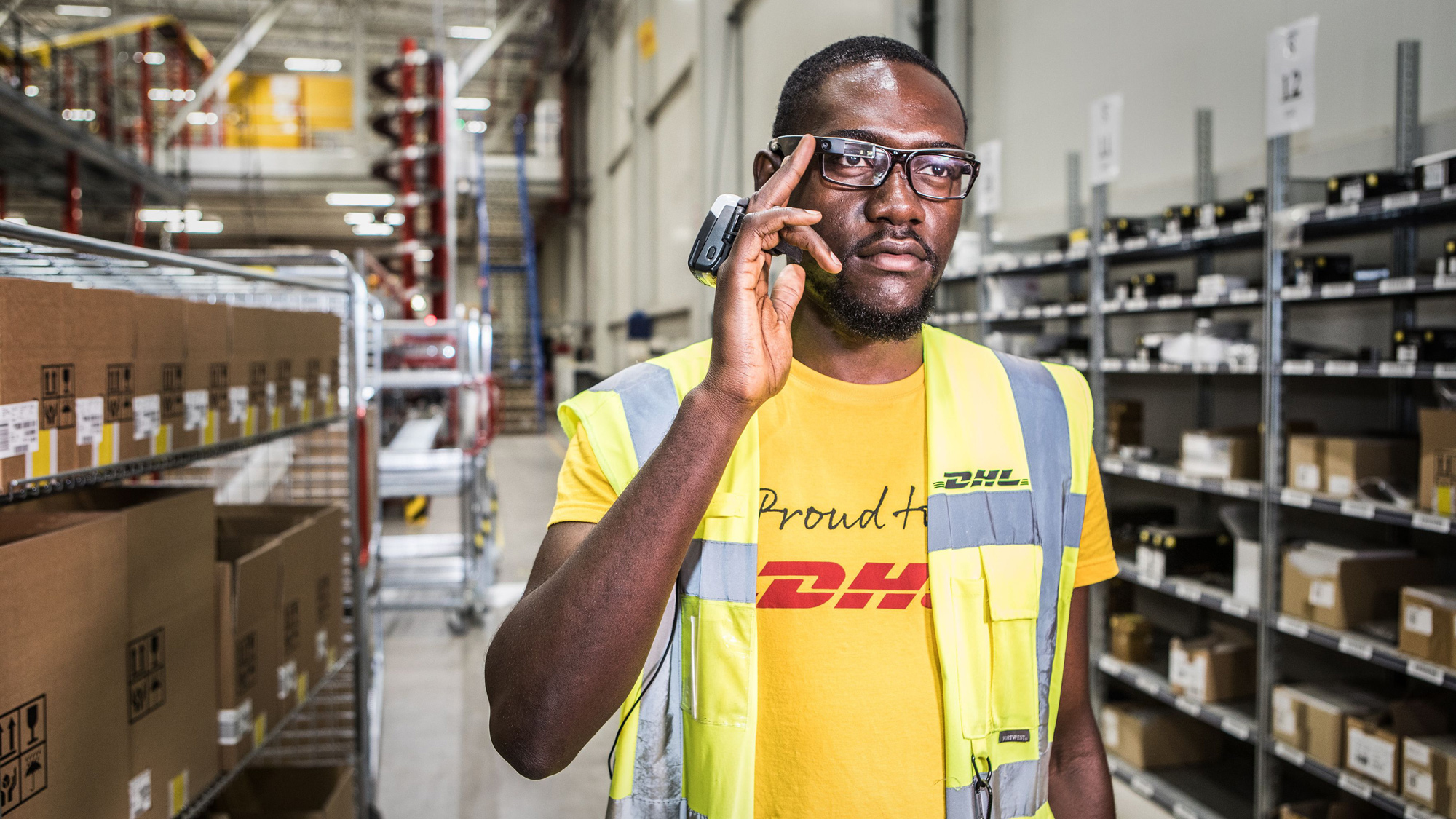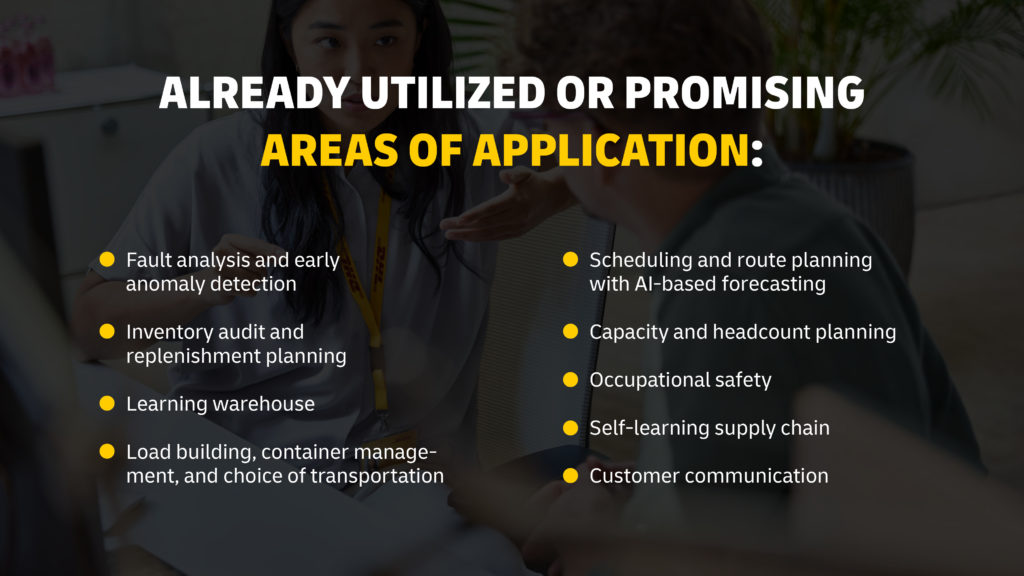
With the presentation of Open AI’s chatbot ChatGPT, artificial intelligence has taken a quantum leap – at least in terms of the number of users from non-technical professions or the overall awareness of the topic. Of course, insiders have long recognized the role of artificial intelligence in logistics and have made appropriate use of it. Here we present current and future fields of potential application.
What Does ChatGPT Itself State About Its Contribution to Logistics?
Before we discuss the part artificial intelligence (AI) already plays in logistics, ChatGPT itself has its say. How does the extremely prominent bot “personally” assess his own value for logistics? We asked the following question: “How can ChatGPT support companies in logistics?”
While the answer is not exactly modest, it is also not as visionary as one might have expected. ChatGPT takes the matter-of-fact view that it can “support companies in logistics in a variety of ways” by increasing efficiency, automating processes, and providing valuable insights into data analysis. A consultant for digitization issues would probably have made a similar point.
When it comes to specific areas of application and possible options for business optimization, ChatGPT indicates that it is able to
- automate manual and time-consuming processes
- forecast delivery times of shipments with the help of data analysis and machine learning
- process customer inquiries and complaints automatically
- analyze large amounts of data to make better decisions and
- train and support employees.
Relevant needs in logistics are identified in this list, albeit without being much specific – some comments on supply chain monitoring or fleet management could have been included. But ChatGPT is still young and adaptive and perhaps these aspects will come with the response to the next request.
Use Case Logistics: AI, Data and Projections
Whether it is ChatGPT or another self-learning communication system, AI has long since evolved from a nerdy computer science topic or attention-grabbing public discussion to an industry standard. AI enables computers to analyze problems, make predictions, recommend solutions to problems, or even make decisions on their own.
There are immense opportunities for the logistics industry to increase efficiency with AI. By providing instant accurate information, streamlining communications, automating routine tasks, and providing comprehensive insights into logistical operations, logistics companies can improve performance, increase customer satisfaction, and reduce costs. Some things in the field of AI are still future dreams, but many things have long been part of everyday business in logistics.

Artificial Intelligence in Logistics and Supply Chain Management – Some Examples
Key words like Data Analysis, AI, supply chain surveillance, or logistical process optimization are prime topics. However, there is still a large gap between the actual state of use in individual companies and the actual potential. Many, if not all, players in the logistics market recognize the possibilities, but most are still lagging behind in implementation because they lack expertise or time resources. Others shy away from the investment costs or are slowed down by an inadequate IT infrastructure.
What is already widely practiced – and what is not – therefore varies greatly from company to company. Already utilized or promising areas of application are:
- Fault analysis and early anomaly detection: errors in master data or anomalies in processes can lead to failures or delays. With AI, faults are quickly detected and corrected before they cause damage.
- Inventory audit and replenishment planning: Too little inventory can lead to delivery bottlenecks, too much increases storage costs. Based on the incoming orders, the AI forecasts which quantities of goods should be available when and where.
- Learning warehouse: Improved placement of items in the warehouse, movement analyses and optimization for employees and warehouse robots, and digital site plans: AI accelerates processes in the warehouse. Networking with delivery vehicles and the generation of arrival forecasts contribute to further optimization of the self-learning warehouse.
- Load building, container management, and choice of transportation: Combining different goods into a consolidated shipment and selecting the ideal load carriers or packaging improves space usage in trucks and load safety. AI systems know at an early stage which vehicle is to be loaded with what and how to achieve maximum efficiency during transport.
- Scheduling and route planning with AI-based forecasting: The planning of the route for combined shipments and the composition of the cargo go together. The cargo dictates which destinations should be approached in what order. Experienced employees plan routes very accurately, but a networked AI system has all the relevant information about the route situation in real time and reacts to problems promptly with deliberate route changes.
- Capacity and headcount planning: In Logistics, there are peaks in demand. Some are more difficult to predict than, for example, the peak before Christmas. Sufficient capacity and personnel planning is required to meet demand at all times. Based on sales experience and forecasts, AI calculates capacity and personnel requirements.
- Occupational safety: Workforce applications of AI are not limited to demand planning. AI can also be used for truck driver stress and fatigue detection and warning, for instance. Personalized break recommendations could contribute to occupational safety and thus also prevent accident-related absenteeism.
- Self-learning supply chain: All of the above factors pay off in the self-learning and self-optimizing supply chain. AI replaces phone calls, emails, and text messages. Not only is communication streamlined, but also the planning effort. The possible combinations of transport goods, means of transport, capacities, and possible routes are very complex. Complexity translates into time and personnel costs – which is why the added value of AI for logistics lies primarily in the self-learning supply chain, in which AI identifies the ideal solution in a resource-saving manner. If the supply chain continuously optimizes itself, no product leaves production without the required transport or interim storage capacities available.
- Customer communication: This brings us full circle and back to communication software like ChatGTP. Chatbots can not only improve customer communication, but also human-machine communication in the warehouse or in the driver’s cab. Human employees are increasingly dealing with intelligent systems as “colleagues”. The faster these systems improve human-machine collaboration thanks to AI, the smoother the collaboration.
Logistics is a perfect field of application for AI because we are concerned with very different goods and processes.
Dr. Klaus Dohrmann, Vice President Innovation Europe & Trend Research DHL in interview with Welt
Artificial Intelligence at DHL and DHL Freight
AI is already being used at DHL in many of the areas mentioned above, while test phases are underway or planned for others. Some examples:
Route optimization
Vast amounts of data are generated in transportation management. With powerful data analytics capabilities, DHL’s AI systems monitor shipment movements and identify problems in real time. Locations of stalled consignments are quickly identified, and optional routes are mapped. Based on this data analysis, corrective action can be taken quickly to ensure shipments arrive at their destination on time.
Load optimization
Our AI solution OptiCarton contributes to DHL’s goal of reducing outer packaging made of cardboard by up to 50 percent and thereby significantly reducing CO₂ emissions per shipment. OptiCarton helps to make optimum use of the filling volume of preconfigured cardboards. Depending on the product characteristics, volume, and dimensions of the shipment, the AI software determines the ideal overpack. By means of a visual representation reminiscent of the computer game Tetris, OptiCarton assists employees in making the best possible use of the available space. This not only improves the emissions balance of the consignment, but also reduces shipping costs.
Container load building
AI recognizes different container and package sizes and arranges them for transport in the container in the most space-saving way possible. This improves capacity utilization and reduces the carbon footprint of each container.
Warehouse robots
In some DHL parcel centers, robots take parcels from the conveyor belt and sort them into specific compartments for the respective delivery routes. Due to AI, these DHLBots are more than just industrial robot grippers; they are capable of learning and flexible. With their 3-D camera, they sense the shape of the shipments, scan barcodes, and place them securely. DHLBots can handle around 1,000 shipments per hour with 99 percent accuracy. This frees up time for creative tasks for human colleagues.
Warehouse management
In the DHL logistics centers where parcels are assembled for online retailers, a self-learning program determines the shortest route in the warehouse for each order in a fraction of a second. The algorithm also takes follow-up orders into account and can prioritize orders. Thanks to intelligent planning, warehouse employees save up to half the distance they would otherwise have to walk.
Supply chain surveillance
DHL also monitors all its supply chains with AI. The positions of individual shipments are constantly transparent and if a deviation occurs or disruptions are foreseeable, the algorithm immediately suggests a solution. This allows shipments to reach their destination on time despite disruptions.
Customer service
Customers can participate in this monitoring and are always up-to-date on the status of their shipment. What today is mostly done via websites could soon be performed by dialog robots, something DHL is already working on. Chatbots take the strain off human resources by handling inquiries about shipment tracking or other topics with limited complexity. In addition, chatbots provide analysis data on customer needs and thus help to improve customer satisfaction.
Conclusion
AI in logistics is not an end in itself. At DHL Freight, we rely on AI to constantly improve. But AI not only ensures that shipments reach the consignee safely and on time. The greater efficiency makes our work more sustainable and improves occupational safety for our employees. So, everyone benefits: our customers, our employees, and the environment. If you would like to learn more, we are happy to still talk to you in person. For all our innovation, we at DHL Freight never forget what logistics is also about: people.
Frequently Asked Questions
- What can artificial intelligence be used for in logistics?
The potential applications of artificial intelligence in logistics are manifold. They range from fault analysis and early detection of anomalies to intelligent route planning and stress identification for drivers to the planning of capacities and personnel requirements. Customer communication can also be facilitated by AI.
- How can ChatGPT support companies in logistics?
ChatGPT has the long-term ability to automate manual and time-consuming processes, use data analytics and machine learning to predict delivery times, automatically handle customer inquiries and complaints, analyze large amounts of data for better decision-making, and train and support employees.



